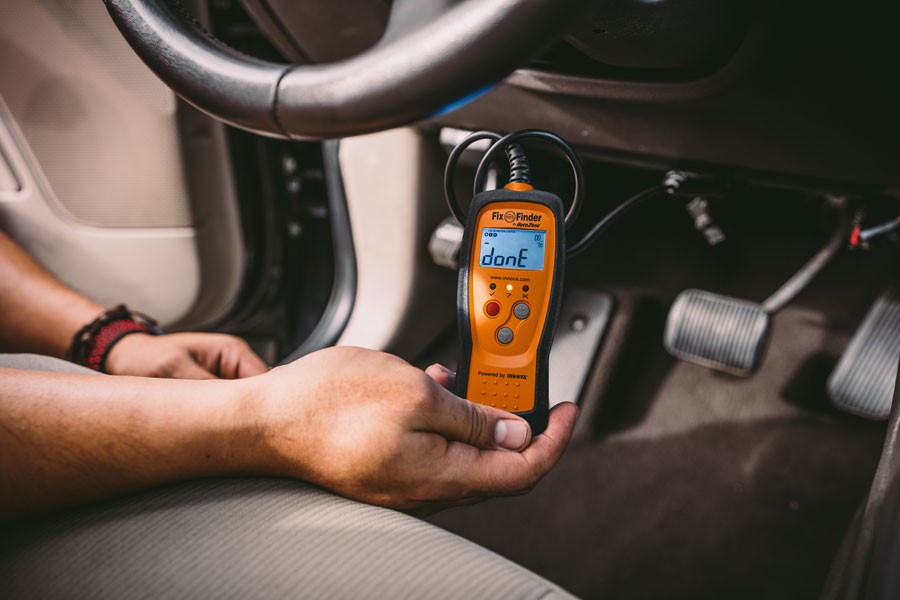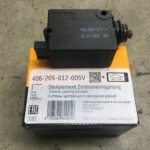Diagnosing car troubles used to require a trip to a mechanic and a hefty bill, even for simple issues. Fortunately, with the advent of affordable and user-friendly diagnostic tools, also known as OBD2 scanners or code readers, you can now get a glimpse into your car’s health right from your driveway. These tools plug into your car’s onboard computer system and can reveal valuable information about what’s going on under the hood, often indicated by that persistent “Check Engine Light”. Learning how to use a diagnostic tool on a car is a valuable skill for any car owner, empowering you to understand your vehicle better, potentially save money on repairs, and make informed decisions about your car’s maintenance. This guide will walk you through the process, making car diagnostics accessible to everyone.
Locating and Connecting Your OBD2 Diagnostic Tool
The first step in using a diagnostic tool is finding your car’s OBDII port. OBDII, which stands for On-Board Diagnostics II, is a standardized system in most cars manufactured after 1996. The port is a universal connector, usually a 16-pin trapezoid-shaped female connector. You’ll typically find it located inside your car’s cabin, mounted under the driver’s side dashboard. In some vehicles, it might be tucked away in the center console or even on the passenger side under the dash, but it’s almost always within easy reach from the driver’s seat.
Connecting your diagnostic tool is designed to be straightforward. The male connector on your scan tool is shaped to fit the OBDII port in only one orientation, ensuring a correct connection. Simply align the trapezoidal shape of the tool’s plug with the port and gently push them together until they are firmly seated. You might feel a slight click or need a gentle wiggle to ensure a secure connection.
To ensure a smooth and proper connection and reading, follow these steps in order:
- Turn off the ignition: Make sure your car’s ignition is completely off before you plug in the diagnostic tool.
- Connect the scan tool: Plug the diagnostic tool connector into the OBDII port as described above.
- Turn the ignition to the “ON” position: Turn your key to the “ON” position, which powers up your car’s electrical systems, but do not start the engine.
- Wait for the tool to power up: In most cases, the OBDII port will provide power to your diagnostic tool automatically.
- Allow the tool to boot up: Give your scan tool a moment to complete its boot sequence and initialize.
Once powered on, your diagnostic tool may prompt you for additional vehicle information. This could include details like engine size, your Vehicle Identification Number (VIN), or instructions on whether to start the engine for certain tests. Follow the on-screen prompts to provide any necessary information.
Navigating the Diagnostic Tool Menu
Once your diagnostic tool has booted up and connected to your car’s computer, you will be presented with a menu on its screen. The complexity of this menu depends on the type of scanner you are using. Basic code readers offer fundamental functions, while more advanced diagnostic scanners provide a wider array of features for in-depth system analysis and testing. However, most tools will include some or all of the following key options:
- Read Codes: This is the most fundamental function. Selecting “Read Codes” instructs the tool to communicate with your car’s computer and retrieve any stored Diagnostic Trouble Codes (DTCs). These codes are essentially error messages generated by your car’s various systems when they detect a problem. The tool will display the DTC number, and often, a brief description of the fault. If multiple codes are present, the tool will typically scroll through each of them.
- Erase Codes: This function allows you to clear stored DTCs from your car’s computer. Navigating to “Erase Codes” and selecting it will usually prompt a confirmation message to prevent accidental code clearing. It’s important to understand that erasing codes does not fix the underlying problem that triggered the code. It only clears the record of the fault. The “Check Engine Light” will typically turn off after clearing codes, but if the issue persists, the light and the code will likely return.
- Live Data: For scanners equipped with this capability, “Live Data” provides real-time sensor readings from various systems in your car. This is invaluable for monitoring engine performance, sensor behavior, and identifying intermittent issues. You can scroll through lists of parameters like engine temperature, RPM, oxygen sensor readings, and more, allowing you to observe values and see if sensors are functioning within expected ranges or if they are failing to respond to changes.
- Freeze Frame: “Freeze Frame” data is a snapshot of vehicle parameters recorded at the exact moment a DTC was set. This information can be incredibly helpful in diagnosing intermittent problems, as it provides context about the conditions under which the fault occurred. It can include parameters like engine speed, engine load, and sensor values at the time of the fault.
- Vehicle Info: This section typically displays basic information about your vehicle, often retrieved directly from the car’s computer system. This may include the VIN, vehicle calibration information, and other build-related data.
- I/M Readiness: “I/M Readiness” stands for Inspection and Maintenance Readiness. This section is particularly relevant for emissions testing or smog checks. It displays the status of various emissions-related systems, indicating whether they have completed their self-tests and are ready for inspection. If any of these readiness monitors are incomplete or show a fault, it could indicate a problem that might prevent your vehicle from passing an emissions test.
Most diagnostic tools, even basic models or Bluetooth/Wi-Fi versions controlled by smartphones, are equipped with buttons for navigation. Arrow buttons allow you to scroll through menu options, a select button confirms your choice, and often a back button is included to return to the previous menu screen.
Understanding Diagnostic Trouble Codes (DTCs)
 Using an OBD2 diagnostic tool to read trouble codes on a car, displaying the diagnostic results on the scanner screen.
Using an OBD2 diagnostic tool to read trouble codes on a car, displaying the diagnostic results on the scanner screen.
When you select “Read Codes” on your diagnostic tool, it will display one or more DTCs. These codes are alphanumeric and follow a standardized format. A typical DTC consists of one letter followed by four numbers, such as P0301.
The first letter of the code indicates the primary vehicle system where the fault is located:
- P (Powertrain): Relates to the engine, transmission, fuel system, and emissions control systems. Powertrain codes are the most common type of DTC.
- B (Body): Indicates issues with body control systems, such as airbags, power windows, interior lighting, and other comfort and convenience features.
- C (Chassis): Points to problems with chassis systems, including the anti-lock braking system (ABS), traction control, suspension, and steering.
- U (Network or Communication): Signifies communication issues within the vehicle’s computer network, often indicating a problem with data exchange between different control modules.
The numbers that follow the letter provide further detail about the specific fault. The first number after the letter (the second character in the code) is either a “0” or a “1”.
- 0: Indicates a generic code. Generic codes are standardized across all vehicle manufacturers, meaning a P0XXX code will have the same general meaning regardless of the car brand.
- 1: Indicates a manufacturer-specific code. These codes are defined by individual car manufacturers and may have slightly different meanings or troubleshooting procedures depending on the vehicle make and model.
The subsequent digits further pinpoint the system and the specific component or circuit affected. For example, the third digit often categorizes the sub-system:
- 1 & 2: Fuel and Air Metering
- 3: Ignition System or Misfire
- 4: Auxiliary Emission Controls
- 5: Vehicle Speed Control & Idle Control
- 7, 8, & 9: Transmission
- A, B, & C: Hybrid Specific
The final two digits provide even more specific details about the fault. With hundreds of potential combinations, understanding the general structure is key to interpreting DTCs.
Using our example code P0301, we can break it down:
- P: Powertrain system
- 0: Generic code
- 3: Ignition system or misfire
- 01: Specific to cylinder #1
Therefore, P0301 indicates a generic powertrain code related to the ignition system, specifically a misfire detected in cylinder #1.
To get a precise definition of a DTC, you can consult online resources, repair manuals, or dedicated DTC lookup tools. Many diagnostic scanners also provide a brief description of the code directly on the screen, offering a starting point for your diagnosis.
Saving Money with a Diagnostic Tool
Investing in a diagnostic tool can lead to significant savings on car repairs in several ways.
Firstly, when your “Check Engine Light” illuminates or you experience a performance issue, using a diagnostic tool provides a crucial first step in identifying the potential source of the problem. While it may not pinpoint the exact failed component, it narrows down the area of concern, giving you valuable insight before taking your car to a mechanic. This pre-diagnosis can help you avoid unnecessary diagnostic fees at a repair shop.
Secondly, a diagnostic tool can help you determine your vehicle’s readiness for emissions testing. The I/M Readiness function can reveal potential issues that might cause your car to fail a smog check, allowing you to address them proactively before the official test.
Furthermore, for those comfortable with DIY car repairs, a diagnostic tool can empower you to tackle certain repairs yourself. For instance, if a scan reveals a code like P0138, indicating a high voltage issue with the bank 1 sensor 2 oxygen sensor, you can research the problem, potentially replace the sensor yourself, and then use your diagnostic tool to clear the code after the repair. This can save you both diagnostic and labor costs at a repair shop.
By learning how to use a diagnostic tool on a car, you gain valuable control over your car’s maintenance and repair process, potentially saving you money, time, and stress in the long run. Consider purchasing an OBDII scanner to equip yourself with this essential tool for modern car ownership and expand your DIY capabilities. Many auto parts stores also offer loaner tool programs, allowing you to borrow a diagnostic scanner at no cost, providing an accessible way to experience the benefits of car diagnostics firsthand.

